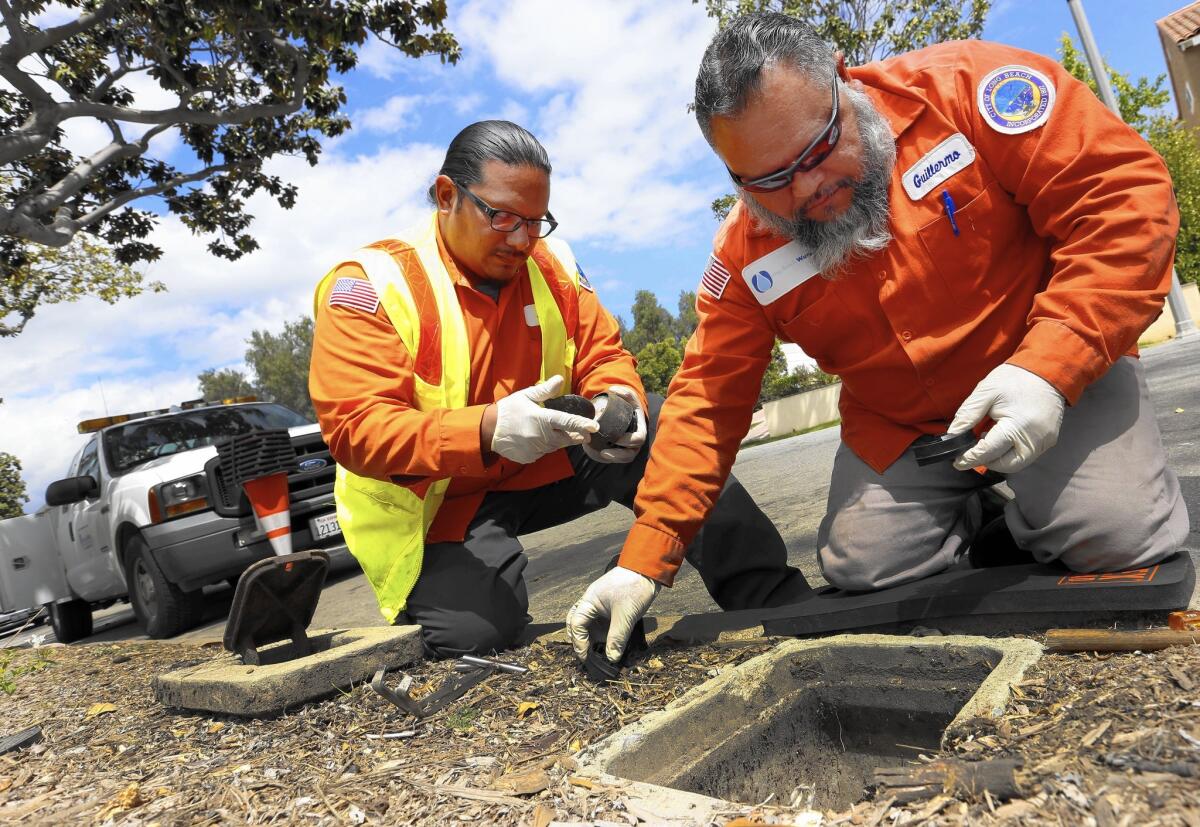Water officials uncertain about just how tough to get with users

- Share via
State regulators told Joone Lopez this week she needs to cut water use in her affluent pocket of southern Orange County by 25%, and she’s not sure she can do it.
As general manager of the Moulton Niguel Water District, she serves communities full of sprawling single-family homes surrounded by verdant lawns and populated by residents who have made it clear they don’t appreciate being fined for using too much water.
Several years ago, the district cracked down on heavy water users, sending inspectors to police the community and issue hundreds of fines. But after about 18 months of loud protests, the district relented.
Despite four years of persistent drought, many local water districts continue to rely primarily on education and outreach to achieve conservation. Officials say those tactics are largely effective because most violators stop wasting water as soon as an agency warns them.
Gov. Jerry Brown’s recent executive order requiring a 25% cut in water use from 2013 levels has communities debating how best to achieve the target. It will probably require several weapons: more fines for chronic water wasters, education and more tiered pricing that makes heavy water users pay significantly more than light users.
Water experts have long said a get-tough approach works better than asking residents to change behavior voluntarily. A 2014 UCLA study examining a decade of Los Angeles Department of Water and Power data showed that for single-family homes, a combination of mandatory watering restrictions and price increases led to a 23% drop in water use, whereas voluntary restrictions led to a 6% reduction over the same period in 2009.
“I don’t think there’s one silver bullet,” said Stephanie Pincetl, who co-authored the study. “But we really, really do need to revise rates. We are not signaling through rates the importance of water conservation.”
Newsha Ajami, director of Urban Water Policy at Stanford University’s Water in the West program, said communities need to employ a range of conservation measures.
But in a drought, Ajami said, adopting tiered pricing and levying fines for water waste are probably the fastest ways of changing behavior. “You need to quickly get to the point.”
Tiered water rate structures, however, come with a tricky legal challenge. State law prohibits water agencies from charging more for water than the cost of producing and delivering it.
Water officials across California are anxiously awaiting an appeals court decision in a San Juan Capistrano case that challenged the legality of the city’s tiered rate structure. If the lower court’s ruling is upheld, rate structures that penalize heavy water use could increasingly come under fire.
Nonetheless, the DWP is considering expanding its price tiers from two to four to make big water users pay even more. The revision would have to be approved by the City Council.
“I think the rates should be even more severe,” said Jonathan Parfrey, a former DWP commissioner and executive director of Climate Resolve, a nonprofit that focuses on how L.A. can adapt to climate change.
“We need to soak the rich for soaking their lawns,” he added. “You gotta price [water] accordingly so it gets their attention.”
But L.A. has been hesitant to fine profligate water users. Officials said they still believe it is still effective to issue informational warnings. The city has cut water use about 10% since early last year and is on track to comply with Mayor Eric Garcetti’s order to slash consumption 20% by 2017.
Since January 2014, the DWP has sent more than 7,300 warning letters and citations. As of Monday, the department had issued only eight $100 fines and two $200 fines for watering violations.
“L.A. residents are good about changing their behaviors to be part of the drought solution,” said DWP spokeswoman Michelle Figueroa. “Citations are written for repeat, egregious offenders, and 10 in a city of 4 million [means] we’re doing pretty good.”
Glendale, too, has focused on education. Water wasters get a verbal warning and a written notice before officials issue a citation, spokesman Tom Lorenz said. Those citations can carry fines of up to $1,000. Since July, the city has issued more than 1,400 written notices and has not levied any fines, Lorenz said.
The threat of the stick — even if officials haven’t used it — helps ensure residents follow the rules, he said.
“We’re not here to criminalize our citizens,” Lorenz said. “But should someone not want to comply with [the ordinance] and they want to be subject to our fines … we’d be more than happy to make an example.”
Many say the best way to encourage conservation is to hit people in their pocketbooks by implementing water rate structures that hammer the heaviest users. Brown’s order specifically calls for water suppliers to develop rate structures and other pricing mechanisms that “maximize water conservation.”
That’s the strategy Moulton Niguel Water District has employed. It revised its rate structure in 2011 and again this month. Now the first tier of water use costs only $1.41 per unit — 748 gallons — while excessive use can increase the cost to as much as $9.04. Officials say the rate structures have helped the district cut use 26% since 2007.
“Our customers understand,” Lopez said. “It’s laid out to them what to expect. If they don’t like people walking up to them on their property and telling them what to do, it puts the choice in their hands. What better signal than price to accentuate the value of the water and incentivize efficient use?”
Some California cities with the most acute water shortages have resorted to stiff penalties for heavy water users.
Facing a water crisis last summer, Santa Cruz imposed a strict rationing program. The city issued $1.6 million in water fines in 2014 and gave violators the option to waive their penalties by attending “water school.” So many people attended that the city collected only about $800,000 in fines.
By year’s end, the city ended rationing and stopped issuing fines. In the wake of Brown’s recent drought order, though, its staff has recommended that the City Council reinstate the city’s rationing program next week.
“We have a lot of carrots to get people to conserve,” said Eileen Cross, spokeswoman for the Santa Cruz Water Department. “But rationing is the stick.”
Down in South Orange County, Lopez isn’t sure exactly how her customers will respond if the district starts adding restrictions or increasing the cost of water.
All she knows is that the agency is unlikely to return to punitive fines for water wasters.
“The memory is very fresh,” she said. “We don’t want to go backwards. … Over the years we’ve done so much to reduce usage, it’s going to be very difficult to reduce that much further.”
[email protected]
Twitter: @bymattstevens
[email protected]
Twitter: @taygoldenstein
[email protected]
Twitter: @boxall
More to Read
Sign up for Essential California
The most important California stories and recommendations in your inbox every morning.
You may occasionally receive promotional content from the Los Angeles Times.













